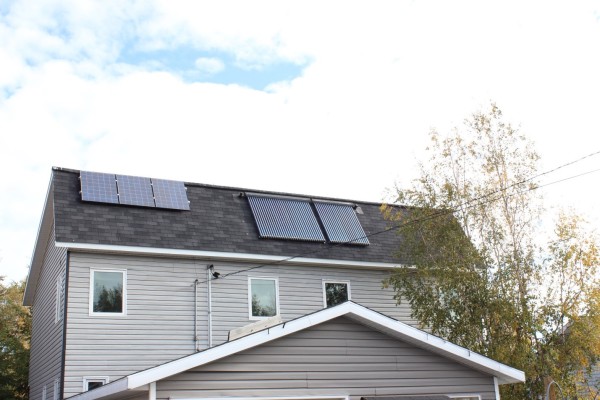The need for renewable energy in the Arctic
Diesel is the primary source of fuel for Arctic communities. Despite its drawbacks – which include air pollution, expense, and risks associated with spills from shipping the fuel to the Far North – diesel fuel is reliable, which is an important consideration for Arctic communities.
While diesel fuel is the norm, renewable energy is beginning to catch on in the North. In September, we went in search of successful Arctic renewable energy projects and visited two remote Arctic communities in Alaska, and one in Canada’s Northwest Territories.
Kotzebue, Alaska is a remote community above the Arctic Circle, with a unique and difficult environment that consists of low, flat tundra terrain marked by permafrost and a port that is only ice-free for 3.5 months each year. Despite these challenging features, the Kotzebue Electric Association erected its first operational wind turbine in 1997.
The day I arrived in Kotzebue, the wind was blowing strong and steady along the Chukchi Sea coast. We drove six kilometres from town and watched the 19 wind turbines spinning against the backdrop of a blue sky. That day, the wind turbines were producing more than 60 per cent of the community’s electricity, supplemented by a single diesel generator to support the 3,200 residents.
Since the first turbine was installed nearly two decades ago, Kotzebue’s wind farm has grown and the electric utility has managed to utilize new technologies, like battery energy storage systems to supply a third of the town’s average annual load. Some days, when the wind electricity generation is more than the community needs, a transformer delivers excess energy to heat a thermal boiler at the hospital.
Today, the total installed capacity of the wind farm has reached three Megawatts and it replaces approximately 250,000 gallons of diesel every year. In addition to improving air quality and reducing the risk to the environment from diesel spills, last year the community saved close to one million dollars in fuel costs.
In Nome, Alaska, a city with 4,000 residents 200 miles southwest of Kotzebue, wind provides seven per cent of its annual electricity consumption and saves 150,000 gallons of diesel and close to half a million dollars each year.
Wind energy is not the only renewable energy technology in Nome. The building of Bering Straits Native Corporation is covered with 16.8 KW PV solar panels that offset 1,000 gallons of diesel per year.
In Nome, I learned of another benefit to reducing diesel consumption in northern communities. In 2012, the Bering Sea iced over before the winter delivery of diesel fuel, and communities were faced with the possibility of not having enough fuel to power their electricity for the winter. A 370-foot Russian tanker was hired to deliver diesel and gasoline, behind a polar icebreaking ship, the Coast Guard Cutter Healy. This costly operation occurred in a very high risk environment. It took almost a week and could have had unrecoverable environmental impacts. See the video below.
Solar energy also has huge diesel consumption reduction potential in the Far North, thanks to long summer days in the Arctic. Solar production potential is the highest in March and April, when days are long and the snow is reflecting additional light. Canada’s Northwest Territories have been particularly successful in harnessing this clean source of energy, thanks to their effective net-metering policy. The city of Yellowknife has many buildings with solar heat and power system.
Solar walls are also operational in Yellowknife with minimal maintenance required. Weledeh Catholic School solar wall is a great example that has been operational and generating solar-heated air since 1998.
Renewable energy technologies are certainly making inroads into the Arctic, helped by the abundance of renewable resources that can be harnessed and the need for a reliable but clean energy alternative to diesel. Over the next five years, WWF-Canada will work to demonstrate that low-impact renewable energy such as wind, solar and hydropower is possible and can contribute to sustainability in northern Canadian communities and a cleaner Arctic environment.







